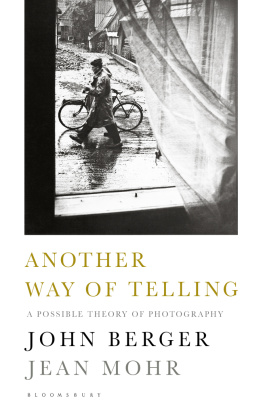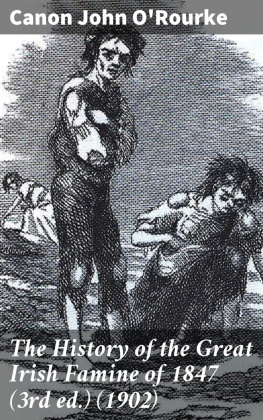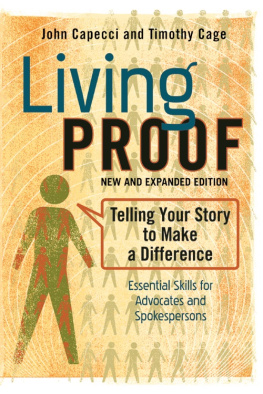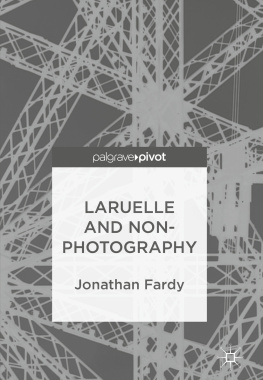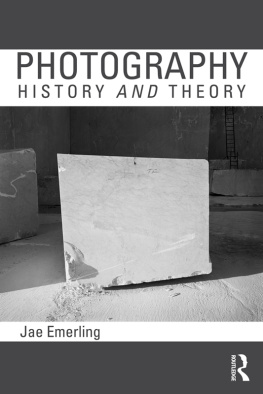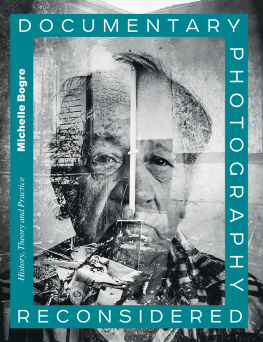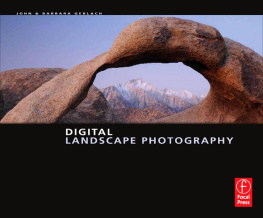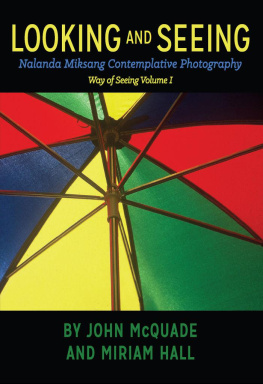John - Another Way of Telling: A New Theory of Photography
Here you can read online John - Another Way of Telling: A New Theory of Photography full text of the book (entire story) in english for free. Download pdf and epub, get meaning, cover and reviews about this ebook. year: 2016, publisher: Bloomsbury Publishing PLC, genre: Religion. Description of the work, (preface) as well as reviews are available. Best literature library LitArk.com created for fans of good reading and offers a wide selection of genres:
Romance novel
Science fiction
Adventure
Detective
Science
History
Home and family
Prose
Art
Politics
Computer
Non-fiction
Religion
Business
Children
Humor
Choose a favorite category and find really read worthwhile books. Enjoy immersion in the world of imagination, feel the emotions of the characters or learn something new for yourself, make an fascinating discovery.
- Book:Another Way of Telling: A New Theory of Photography
- Author:
- Publisher:Bloomsbury Publishing PLC
- Genre:
- Year:2016
- Rating:5 / 5
- Favourites:Add to favourites
- Your mark:
- 100
- 1
- 2
- 3
- 4
- 5
Another Way of Telling: A New Theory of Photography: summary, description and annotation
We offer to read an annotation, description, summary or preface (depends on what the author of the book "Another Way of Telling: A New Theory of Photography" wrote himself). If you haven't found the necessary information about the book — write in the comments, we will try to find it.
John: author's other books
Who wrote Another Way of Telling: A New Theory of Photography? Find out the surname, the name of the author of the book and a list of all author's works by series.
Another Way of Telling: A New Theory of Photography — read online for free the complete book (whole text) full work
Below is the text of the book, divided by pages. System saving the place of the last page read, allows you to conveniently read the book "Another Way of Telling: A New Theory of Photography" online for free, without having to search again every time where you left off. Put a bookmark, and you can go to the page where you finished reading at any time.
Font size:
Interval:
Bookmark:
ALSO BY JOHN BERGER
FICTION
The Foot of Clive
Corkers Freedom
A Fortunate Man
A Seventh Man
G
The Trilogy: Into Their Labours (Pig Earth,
Once in Europa, Lilac and Flag)
And Our Faces, My Heart, Brief as Photos
Photocopies
To the Wedding
King
Here is Where We Meet
From A to X
POETRY
Pages of the Wound
NON-FICTION
A Painter of Our Time
Permanent Red
Art and Revolution
The Moment of Cubism and Other Essays
The Look of Things: Selected Essays and Articles
Ways of Seeing
The Success and Failure of Picasso
About Looking
The Sense of Sight
Keeping a Rendezvous
The Shape of a Pocket
Selected Essays of John Berger (ed. Geoff Dyer)
Titian: Nymph and Shepherd (with Katya Berger)

Bloomsbury Publishing
An imprint of Bloomsbury Publishing Plc
50 Bedford Square | 1385 Broadway |
London | New York |
WC1B 3DP | NY 10018 |
UK | USA |
www.bloomsbury.com
This electronic edition published in 2016 by Bloomsbury Publishing Plc
BLOOMSBURY and the Diana logo are trademarks of Bloomsbury Publishing Plc
First published in Great Britain 1982 by
Writers and Readers Publishing Cooperative Society Ltd
This edition first published in 2016
Copyright John Berger and Jean Mohr 1982
John Berger and Jean Mohr have have asserted their rights under the Copyright, Designs and Patents Act, 1988, to be identified as Authors of this work.
All rights reserved.
You may not copy, distribute, transmit, reproduce or otherwise make available this publication (or any part of it) in any form, or by any means (including without limitation electronic, digital, optical, mechanical, photocopying, printing, recording or otherwise), without the prior written permission of the publisher. Any person who does any unauthorised act in relation to this publication may be liable to criminal prosecution and civil claims for damages.
No responsibility for loss caused to any individual or organization acting on or refraining from action as a result of the material in this publication can be accepted by Bloomsbury or the author.
British Library Cataloguing-in-Publication Data
A catalogue record for this book is available from the British Library.
ISBN: Tpb: 978-1-4088-6445-6
ePub: 978-1-4088-6446-3
To find out more about our authors and books visit www.bloomsbury.com.
Here you will find extracts, author interviews, details of forthcoming events and the option to sign up for our newsletters.
For Beverly and Simone
This book would not have been possible without the support, both financial and theoretical, of the Transnational Institute, Amsterdam. I would like, once again, to express my solidarity with this Institute. J.B.
Preface
We wanted to make a book of photographs about the lives of mountain peasants. During seven years the men and women from our village and in the nearby valleys have collaborated with us. What we show is in the most profound sense their lifes work.
We also wanted to produce a book about photography. Everyone in the world is now familiar with photographs and cameras. And yet what is a photograph? What do photographs mean? How can they be used? Such questions which began to be asked with the invention of the camera have not, until now, been fully answered.
Our book is divided into five parts. In the first, Jean Mohr writes about aspects of his experience as a photographer, and particularly those aspects which illustrate how photographs are ambiguous. A photograph is a meeting place where the interests of the photographer, the photographed, the viewer and those who are using the photograph are often contradictory. These contradictions both hide and increase the natural ambiguity of the photographic image.
The second part is an essay which explores a possible theory of photography. Most theoretical writing about the medium has limited itself to either the purely empirical or to the purely aesthetic. Yet photography naturally leads to the question of the meaning of appearances in themselves.
The third part of our book consists of a sequence of a hundred and fifty photographs without words. This sequence entitled If Each Time... is a reflection upon a peasant womans life. It is not a report-age. We hope that it may read as a work of imagination.
The fourth part discusses some of the theoretical implications of the way we have tried to tell a story in If Each Time.... The final very brief section is a reminder of the reality from which we began: the life work of peasants.
Beyond my camera
by Jean Mohr

WHAT ARE YOU DOING THERE?
A Sunday afternoon in autumn. The large market square of the country town of B... It was sunny, but it wasnt a sun that warmed, it simply shone with its violent light on people and things. Some were directly in this light, some were in shadow. There were no half-measures about this light. The peasants from the neighbouring countryside paid little attention to the quality of light; they had come to the fair to buy or sell cattle.
As for me this violent sunlight posed certain technical problems. I would have preferred a cloudy sky, even mist. Making my way between the cattle, the peasants and the cattle dealers, I was looking for some angle of approach. Warming-up in both senses of the word. I wasnt playing any games, I dont like that, I wasnt pretending not to take photographs. In any case its not easy to trick a Savoyard peasant. And I prefer to be frank about what Im doing, whenever its possible.
Near a line of calves some men were talking. Dryly. They had seen me but were pretending to ignore me. Suddenly one of them spoke out, not really aggressively, but rather more to amuse his colleagues.
So what are you doing there?
Im taking some pictures of you and your cattle.
Youre taking some pictures of my cows! Would you believe it? Hes helping himself to my cows without having to pay a sou for them!
I laughed along with the others. And I went on taking my photos. That is to say, taking in my own way what was before my eyes and what interested me, without paying and without asking permission.

THE STRANGER WHO IMITATED ANIMALS...
I was visiting my sister, who lives in the university town of Aligarh in India. The previous evening, when I first arrived, she had warned me: Dont be surprised if youre woken up early in the morning. Theres a young girl, a neighbour, who is blind, but who likes to know what is happening. She may well come to see who the new arrival is.
Tired by the long journey in the train that had stopped at every station, I quickly fell asleep. And when I awoke next morning, it took me several minutes to remember where I was. I could hear something scratching near the window, a fingernail lightly rasping against the mosquito net. The young blind girl said Good Morning. The sun had been up for several hours.
Next pageFont size:
Interval:
Bookmark:
Similar books «Another Way of Telling: A New Theory of Photography»
Look at similar books to Another Way of Telling: A New Theory of Photography. We have selected literature similar in name and meaning in the hope of providing readers with more options to find new, interesting, not yet read works.
Discussion, reviews of the book Another Way of Telling: A New Theory of Photography and just readers' own opinions. Leave your comments, write what you think about the work, its meaning or the main characters. Specify what exactly you liked and what you didn't like, and why you think so.

